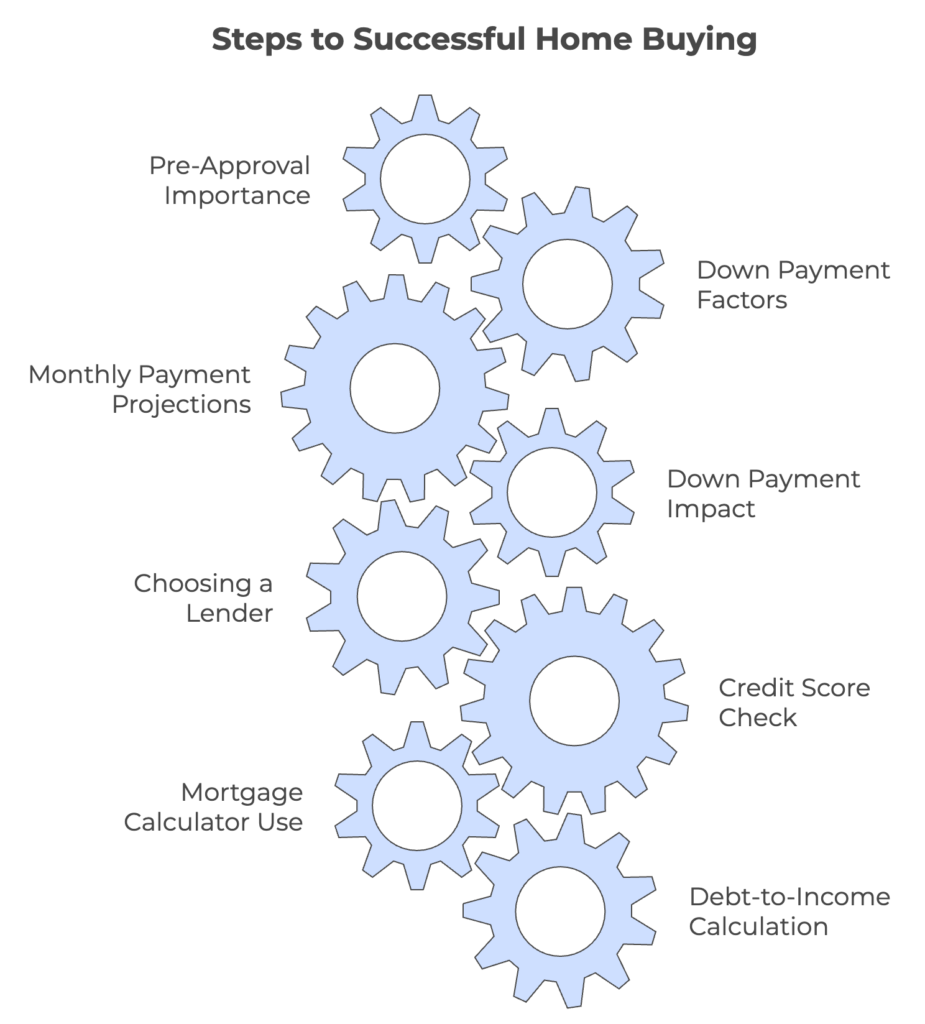The Mortgage Process
Unless you’re planning to pay cash for your home, getting pre-approved for a mortgage is a crucial step before you begin house hunting. In fact, a pre-approval letter from a lender is required to make an offer on a property. Starting the pre-approval process early gives you the advantage of knowing your budget and strengthens your negotiating position. It also helps narrow your search by providing a clear understanding of what you can afford.

Key Factors to Consider During the Mortgage Process:
Down Payment Requirements & Mortgage Insurance
What’s the minimum down payment needed? How do different down payment amounts affect your mortgage rate? You’ll also want to consider how Private Mortgage Insurance (PMI) comes into play if your down payment is less than 20%.Projected Monthly Payments for Different Price Ranges
Understanding how much you can afford monthly is essential. Use different price points to compare prospective mortgage payments, and be sure to factor in all components, including Principal, Interest, Taxes, and Insurance (PITI).Impact of Down Payment on Monthly Payments
The size of your down payment will affect your monthly payments. We’ll help you explore how putting more or less money down on a specific price point changes your financial picture.
Answering these questions will give you clarity on your price range, helping us target homes that fit your budget.
Need a Lender Referral?
We work with trusted local lenders who offer competitive rates and excellent service. If you need a referral, just ask! Here’s what we suggest when choosing a lender:
Go Local
Local mortgage bankers rely on referrals and have a vested interest in closing your loan on time. They’re motivated to maintain a solid reputation within the community, so you can count on personalized service.Use a Specialist
Working with a loan originator (LO) who specializes in mortgages is key. Many LOs are commission-based, meaning they’re incentivized to get your loan approved and closed on time.Check Reviews
Look for a lender with a strong online presence, including positive reviews on platforms like Yelp, Google, or Angie’s List. A lender who values their reputation is more likely to provide top-notch service.Avoid Large National Banks
While it may seem convenient to use your existing bank for a mortgage, national retail banks often have underwhelming customer service in their mortgage departments. These banks tend to employ lower-paid staff, which can lead to delays and frustration during the process.
Getting Started on Your Own:
If you’re not ready to speak with a lender, here are a few steps to take on your own:
Check Your Credit Score
Head over to CreditKarma.com to check your score. A score of at least 660 is typically required to qualify for most loans (though FHA & VA loans can be more lenient). The best rates are generally available for borrowers with scores of 740 or higher.Use a Mortgage Calculator
Find an online calculator or app that factors in Principal, Interest, Taxes, and Insurance (PITI). Keep in mind that property taxes in Texas are often higher than calculators assume. For Android, we recommend Karl’s Mortgage Calculator, and while we suggest avoiding Quicken Loans for your actual mortgage, their app is quite user-friendly.Calculate Your Debt-to-Income Ratio (DTI)
Your DTI is your total monthly debt payments (student loans, car loans, credit cards, etc.) divided by your gross monthly income. Lenders typically approve buyers with a DTI of 50% or lower, so add in potential mortgage payments (PITI) to see how much home you can afford.
Taking these steps will set you up for success and give you the knowledge and confidence to begin your home search with clarity.
- Services
Buyer Services
- Comprehensive Home Search
- Local Market Expertise
- Property Tours
- Mortgage Assistance
- New Construction Exclusives
- Offer Negotiation
- Inspection Support
- Appraisal Support
- Closing Process Support
- First-Time Buyer Guidance
- Investment Property Support
- Relocation Services
